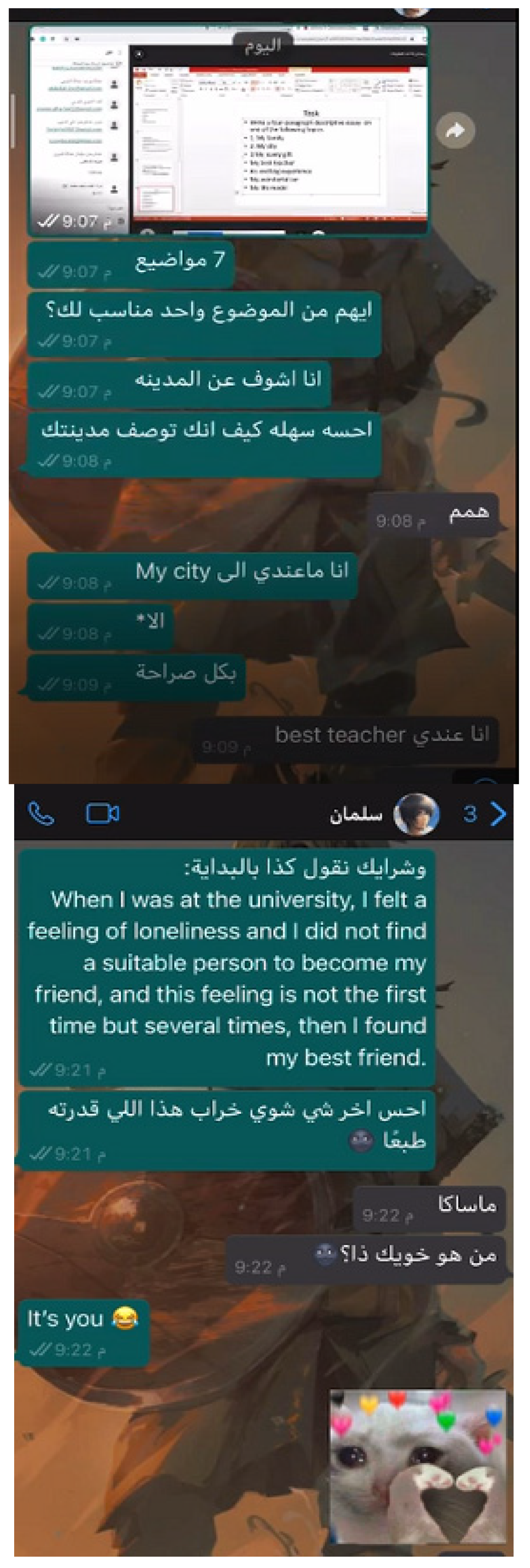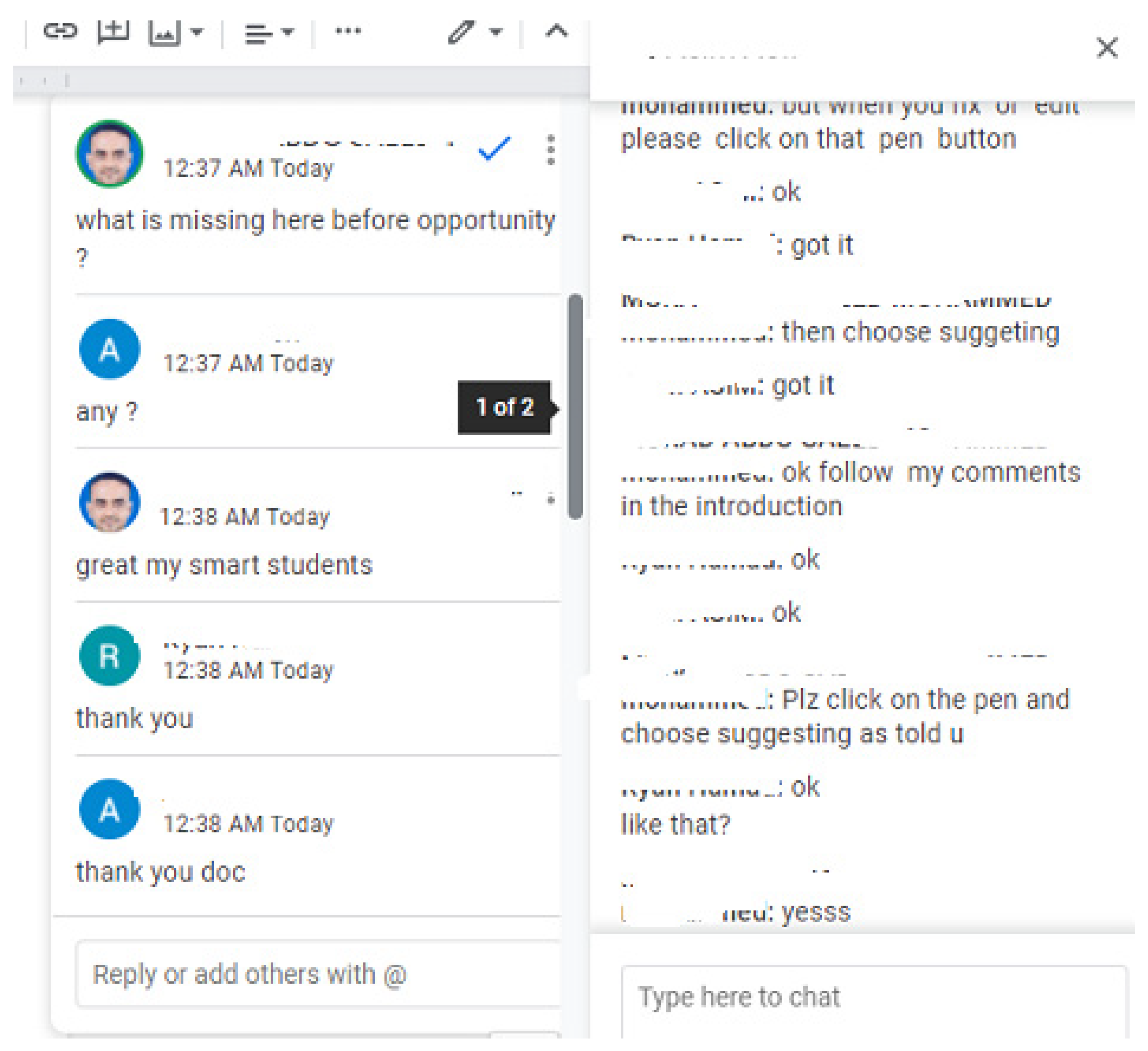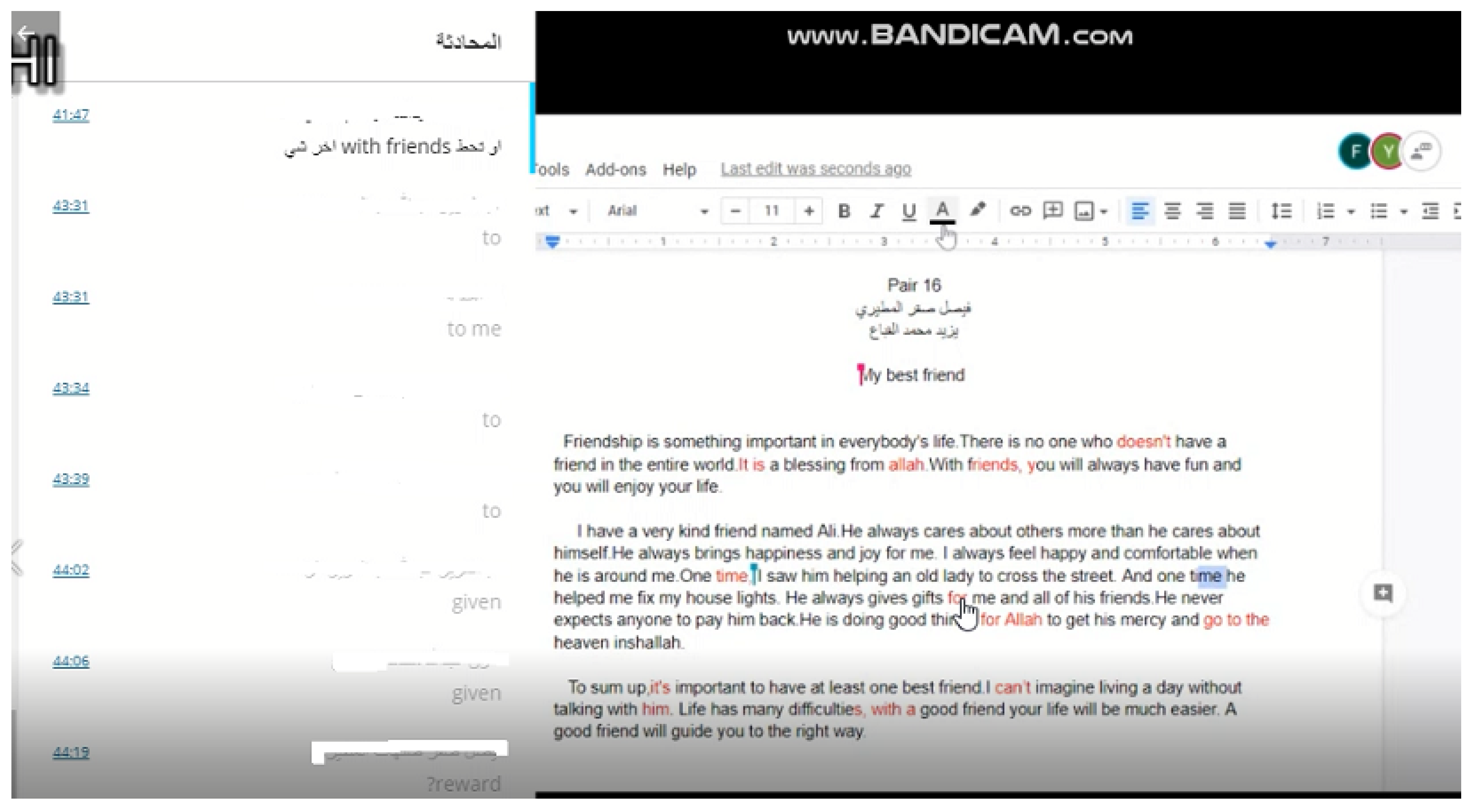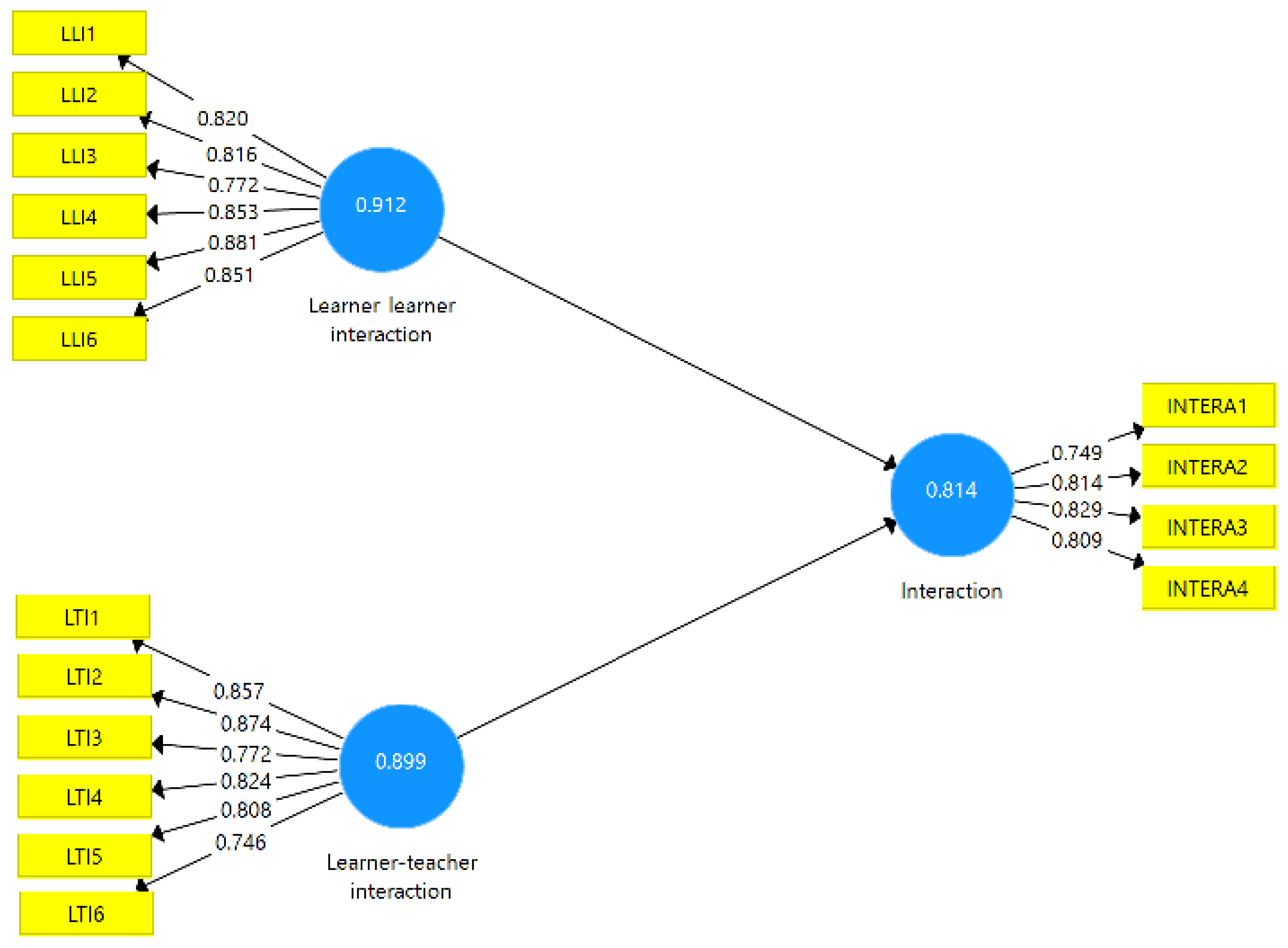Sustaining Synchronous Interaction Effectiveness in Distance Writing Courses: A Mixed Method Study in a KSA University
Abstract
:1. Introduction
- What are the patterns of interaction promoted and sustained through a combination of technological tools and a collaborative writing approach in the selected online writing courses?
- How did the EFL learners joining the three online writing courses perceive the technology-supported interaction in peer writing?
- How did the learners’ factors (e.g., learner-related factors and technology-related factors) affect their interaction in these three online writing courses?
2. Theoretical Perspective on Interaction
3. Computer-Mediated Interactions
4. Hypothesis Development
5. Method
5.1. Study Setting
5.2. Data Collection
5.3. Data Analyses
5.3.1. Qualitative Data
- S2P8: بس مافهمت اللي في اللون الاخضر المائل But I could not get the sentences in green colour highlights and italics (Voice)
- S1P8: Oh that means not related to the topic because I guess the sentences talk about importance of writing not the writing class. (Voice)
- S2P8: Wow you are genius! (Written)
- S1P8: Thank you. (Voice)
- S1P8: So can we remove them? (Written)
- S2P8: Yes or we can change them by others related to our topic. (Written)
5.3.2. Quantitative Data
6. Findings
6.1. Patterns of Interaction in the Online Writing Courses Sustained through Technological Tools and Instructional Designs
6.1.1. Learner-Learner Interaction
- S2P8: بس مافهمت اللي في اللون الاخضر المائل But I could not get the sentences in green colour highlights and italics (Voice)
- S1P8: Oh that means not related to the topic because I guess the sentences talk about importance of writing not the writing class. (Voice)
- S2P8: Wow you are genius! (Written)
- S1P8: Thank you. (Voice)
- S1P8: So can we remove them? (Written)
- S2P8: Yes or we can change them by others related to our topic. (Written)
6.1.2. Teacher-Learner Interaction
- T: Teacher highlights the noun emotion:
. What do you mean by this? (Highlight + Voice in SSF sessions)
- P3: Silent.
- T: Asking the class: Do you know its meaning? (Voice)
- S2P7: It means sad feelings Dr. (Written)
- T: Oh great but does not it look general? (Voice)
- S1P13: يعني تبيهم يغيروها دكتور Do you want them to change it? (Voice)
- T: I think yes better to make it specific. (Voice)
- S2P10: So what about feeling? (Written)
- T: I guess it is still the same. Calling student-authors by names. You can change it into expression. You know expression? (Voice)
- S2P8: Yes Dr. تعابيير (Expressions). (Written)
- T: Spelling out the word: E-X-P for people –R-E-Double SS-I-O-N. (Voice)
- S2P3: Deleting “emotion” and replacing it with “expression” following the teacher’s spelled out alphabets of the word.
(Written through Google Docs suggested edits)
- T: Bravo now. (Voice)
6.1.3. Learner-Teacher Interaction
- S1P9: Sorry Dr. We were discussing this comment but we couldn’t get it.
- T: So what do you think about it? Does it reflect the body?
- S1P9: Oh I think we need to be more specific so can we write it again?
- S2P9: Sorry we planned to delete it.
- T: Why deleting it?
- S1P9: Can we make them more focused? How is it now Dr.?
- T: Great for you.
- S1P12: Hi doctor. You told us to change the entire body so we changed it but I don’t know if you checked it. Because I am afraid to submit it with mistakes. (Written)
- T: You can refer back to the recorded session. (Voice)
- S1P12: Doctor. We are pair 12, and you told us to change the entire body, but it seems you have not seen it yet. (Written).
- S2P12: Ok Doctor but can you read the body we changed to see the errors if you are free? (Voice).
- T: Ok wait. (Written)
- S1P12: Ok take your time Doctor. (Written)
- T: So what do you think of the comment?
- S1P12: I think you wanted us to be more specific. Am I right dr? (Written)
- T: Great so do it. (Voice)
- S1P14: Raising hand sign in the whole class session.
- T: Yes (calling his name). Any question? (Voice)
- S1P14: I am sorry Dr. to disturb you. But why you asked Pair 10 to change the tense to the present perfect? (Voice)
- T: A great question. Who can answer it? (Voice)
- S2P5: Easy. (Written)
- S2P6: Because to talk about things during a period stated from the past. (Written)
- T: Great but what do you mean from the past? Can you give an example? (Voice)
- S2P6: Silent.
- T: Who can give an example? (Voice)
- S2P10: We have been friends since our secondary school days. (Written)
- T: Bravo and an excellent example. So what words and phrases do we usually use for this tense? (Voice)
- S2P13: For and since. (Written)
- T: Great and is it clear now? (Voice)
- S1P14: Yes got it. Thank you all. (Written)
6.2. Learners’ Perception of Technology-Facilitated Interaction
6.2.1. Measurement Model
6.2.2. Structural Model
6.2.3. Qualitative Data Analysis
6.3. Factors Affecting Learners’ Perceived Interaction
7. Discussion
8. Conclusions
Author Contributions
Funding
Institutional Review Board Statement
Informed Consent Statement
Conflicts of Interest
References
- Alghasab, M.; Hardman, J.; Handley, Z. Teacher-student interaction on wikis: Fostering collaborative learning and writing. Learn. Cult. Soc. Interact. 2019, 21, 10–20. [Google Scholar] [CrossRef]
- Yeh, H.-C. Exploring how collaborative dialogues facilitate synchronous collaborative writing. Lang. Learn. Technol. 2014, 18, 23–37. [Google Scholar]
- Rojas-Drummond, S.; Mercer, N. Scaffolding the development of effective collaboration and learning. Int. J. Educ. Res. 2003, 39, 99–111. [Google Scholar] [CrossRef]
- Webb, N.M. The teacher’s role in promoting collaborative dialogue in the classroom. Br. J. Educ. Psychol. 2009, 79, 1–28. [Google Scholar] [CrossRef]
- Zeng, G.; Takatsuka, S. Text-based peer–peer collaborative dialogue in a computer-mediated learning environment in the EFL context. System 2009, 37, 434–446. [Google Scholar] [CrossRef]
- Alharbi, M.A. Exploring the potential of Google Doc in facilitating innovative teaching and learning practices in an EFL writing course. Innov. Lang. Learn. Teach. 2020, 14, 227–242. [Google Scholar] [CrossRef]
- Saeed, A.M.; Ghazali, K. Asynchronous group review of EFL writing: Interactions and text revisions. Lang. Learn. Technol. 2017, 21, 200–226. [Google Scholar]
- Kara, M. Transactional distance and learner outcomes in an online EFL context. Open Learn. J. Open Distance e-Learn. 2021, 36, 45–60. [Google Scholar] [CrossRef]
- Dutta, B.; Peng, M.-H.; Chen, C.-C.; Sun, S.-L. Interpreting Usability Factors Predicting Sustainable Adoption of Cloud-Based E-Learning Environment during COVID-19 Pandemic. Sustainability 2021, 13, 9329. [Google Scholar] [CrossRef]
- Kohnke, L.; Jarvis, A. Coping with English for Academic Purposes Provision during COVID-19. Sustainability 2021, 13, 8642. [Google Scholar] [CrossRef]
- Alshaikh, K.; Maasher, S.; Bayazed, A.; Saleem, F.; Badri, S.; Fakieh, B. Impact of COVID-19 on the Educational Process in Saudi Arabia: A Technology–Organization–Environment Framework. Sustainability 2021, 13, 7103. [Google Scholar] [CrossRef]
- Petchamé, J.; Iriondo, I.; Villegas, E.; Riu, D.; Fonseca, D. Comparing Face-to-Face, Emergency Remote Teaching and Smart Classroom: A Qualitative Exploratory Research Based on Students’ Experience during the COVID-19 Pandemic. Sustainability 2021, 13, 6625. [Google Scholar] [CrossRef]
- Choi, L.; Chung, S. Navigating online language teaching in uncertain times: Challenges and strategies of EFL educators in creating a sustainable technology-mediated language learning environment. Sustainability 2021, 13, 7664. [Google Scholar] [CrossRef]
- Chen, J.C.; Dobinson, T.; Kent, S. Lecturers’ perceptions and experiences of Blackboard Collaborate as a distance learning and teaching tool via Open Universities Australia (OUA). Open Learn. J. Open Distance e-Learn. 2020, 35, 222–235. [Google Scholar] [CrossRef]
- Ishtaiwa, F.F.; Aburezeq, I.M. The impact of Google Docs on student collaboration: A UAE case study. Learn. Cult. Soc. Interact. 2015, 7, 85–96. [Google Scholar] [CrossRef]
- Liang, M.-Y. Using synchronous online peer response groups in EFL writing: Revision-related discourse. Lang. Learn. Technol. 2010, 14, 45–64. [Google Scholar]
- Elola, I.; Oskoz, A. Collaborative writing: Fostering foreign language and writing conventions development. Lang. Learn. Technol. 2010, 14, 51–71. [Google Scholar]
- Saeed, A.M.; Al Qunayeer, H.S. Exploring teacher interactive e-feedback on students’ writing through Google Docs: Factors promoting interactivity and potential for learning. Lang. Learn. J. 2020, 1–18. [Google Scholar] [CrossRef]
- Cho, H. Synchronous web-based collaborative writing: Factors mediating interaction among second-language writers. J. Second. Lang. Writ. 2017, 36, 37–51. [Google Scholar] [CrossRef]
- Wood, J. Making peer feedback work: The contribution of technology-mediated dialogic peer feedback to feedback uptake and literacy. Assess. Eval. High. Educ. 2021, 1–20. [Google Scholar] [CrossRef]
- Viberg, O.; Grönlund, Å.; Andersson, A. Integrating digital technology in mathematics education: A Swedish case study. Interact. Learn. Environ. 2020, 1–12. [Google Scholar] [CrossRef]
- Li, M. Computer-mediated collaborative writing in L2 contexts: An analysis of empirical research. Comput. Assist. Lang. Learn. 2018, 31, 882–904. [Google Scholar] [CrossRef]
- Li, M.; Kim, D. One wiki, two groups: Dynamic interactions across ESL collaborative writing tasks. J. Second. Lang. Writ. 2016, 31, 25–42. [Google Scholar] [CrossRef]
- Storch, N. Collaborative writing. Lang. Teach. 2019, 52, 40–59. [Google Scholar] [CrossRef]
- Abrams, Z. Exploring collaboratively written L2 texts among first-year learners of German in Google Docs. Comput. Assist. Lang. Learn. 2016, 29, 1259–1270. [Google Scholar] [CrossRef]
- Elabdali, R.; Arnold, N. Group Dynamics across Interaction Modes in L2 Collaborative Wiki Writing. Comput. Compos. 2020, 58, 102607. [Google Scholar] [CrossRef]
- Wigglesworth, G.; Storch, N. What role for collaboration in writing and writing feedback. J. Second. Lang. Writ. 2012, 21, 364–374. [Google Scholar] [CrossRef]
- Merkel, W. Role reversals: A case study of dialogic interactions and feedback on L2 writing. J. Second. Lang. Writ. 2018, 39, 16–28. [Google Scholar] [CrossRef]
- Steen-Utheim, A.; Wittek, A.L. Dialogic feedback and potentialities for student learning. Learn. Cult. Soc. Interact. 2017, 15, 18–30. [Google Scholar] [CrossRef] [Green Version]
- Liu, M.; Liu, L.; Liu, L. Group awareness increases student engagement in online collaborative writing. Internet High. Educ. 2018, 38, 1–8. [Google Scholar] [CrossRef]
- Williams, J.; Severino, C. The writing center and second language writers. J. Second. Lang. Writ. 2004, 3, 165–172. [Google Scholar] [CrossRef]
- Long, M.H. Input, Interaction, and Second Language Acquisition; University of California: Los Angeles, CA, USA, 1980. [Google Scholar]
- Pica, T. Research on negotiation: What does it reveal about second-language learning conditions, processes, and outcomes? Lang. Learn. 1994, 44, 493–527. [Google Scholar] [CrossRef]
- Vygotsky, L.S. Socio-cultural theory. Mind Soc. 1978, 6, 52–58. [Google Scholar]
- Hanjani, M.A.; Li, L. Exploring L2 writers’ collaborative revision interactions and their writing performance. System 2014, 44, 101–114. [Google Scholar] [CrossRef] [Green Version]
- Gikandi, J.; Morrow, D. Designing and implementing peer formative feedback within online learning environments. Technol. Pedagog. Educ. 2016, 25, 153–170. [Google Scholar] [CrossRef]
- Orsmond, P.; Maw, S.J.; Park, J.R.; Gomez, S.; Crook, A.C. Moving feedback forward: Theory to practice. Assess. Eval. High. Educ. 2013, 38, 240–252. [Google Scholar] [CrossRef]
- Chen, S.; Ouyang, F.; Jiao, P. Promoting student engagement in online collaborative writing through a student-facing social learning analytics tool. J. Comput. Assist. Learn. 2021. [Google Scholar] [CrossRef]
- Schillings, M.; Roebertsen, H.; Savelberg, H.; Dolmans, D. A review of educational dialogue strategies to improve academic writing skills. Act. Learn. High. Educ. 2018. [Google Scholar] [CrossRef]
- Zhu, Q.; Carless, D. Dialogue within peer feedback processes: Clarification and negotiation of meaning. High. Educ. Res. Dev. 2018, 37, 883–897. [Google Scholar] [CrossRef]
- Yang, M.; Carless, D. The feedback triangle and the enhancement of dialogic feedback processes. Teach. High. Educ. 2013, 18, 285–297. [Google Scholar] [CrossRef] [Green Version]
- Adie, L.; van der Kleij, F.; Cumming, J. The development and application of coding frameworks to explore dialogic feedback interactions and self-regulated learning. Br. Educ. Res. J. 2018, 44, 704–723. [Google Scholar] [CrossRef]
- Godwin-Jones, R. Second language writing online: An update. Lang. Learn. Technol. 2018, 22, 1–15. [Google Scholar]
- Sung, -T.Y.; Chang, K.-E.; Liu, T.-C. The effects of integrating mobile devices with teaching and learning on students’ learning performance: A meta-analysis and research synthesis. Comput. Educ. 2016, 94, 252–275. [Google Scholar] [CrossRef] [Green Version]
- Wrigglesworth, J. Using smartphones to extend interaction beyond the EFL classroom. Comput. Assist. Lang. Learn. 2020, 33, 413–434. [Google Scholar] [CrossRef]
- Xu, Q.; Peng, H. Investigating mobile-assisted oral feedback in teaching Chinese as a second language. Comput. Assist. Lang. Learn. 2017, 30, 173–182. [Google Scholar] [CrossRef]
- Satar, M.H.; Wigham, C.R. Multimodal instruction-giving practices in webconferencing-supported language teaching. System 2017, 70, 63–80. [Google Scholar] [CrossRef] [Green Version]
- Torun, E.D. Synchronous interaction in online learning environments with Adobe Connect Pro. Procedia-Soc. Behav. Sci. 2013, 106, 2492–2499. [Google Scholar] [CrossRef] [Green Version]
- Ekwunife-Orakwue, C.K.; Teng, T.-L. The impact of transactional distance dialogic interactions on student learning outcomes in online and blended environments. Comput. Educ. 2014, 78, 414–427. [Google Scholar] [CrossRef]
- Huang, X.; Chandra, A.; DePaolo, C.A.; Simmons, L.L. Understanding transactional distance in web-based learning environments: An empirical study. Br. J. Educ. Technol. 2016, 47, 734–747. [Google Scholar] [CrossRef]
- Vasiloudis, G.; Koutsouba, M.; Giossos, Y.; Mavroidis, I. Transactional distance and autonomy in a distance learning environment. Eur. J. Open Distance E-Learn. 2015, 18, 114–122. [Google Scholar] [CrossRef] [Green Version]
- Montanero, M.; Marques, M.-J. “Explain it on the blackboard”. An analysis of the educational interaction in mirror assessment activities. Learn. Cult. Soc. Interact. 2019, 22, 100247. [Google Scholar] [CrossRef]
- Creswell, J.W. Qualitative, Quantitative and Mixed Methods Approaches; Sage: Thousand Oaks, CA, USA, 2014. [Google Scholar]
- Hair, F.J.; Ringle, C.; Sarstedt, M. Journal of Marketing Theory and Practice PLS-SEM: Indeed a silver bullet. J. Mark. Theory Pract. 2011, 19, 139–152. [Google Scholar] [CrossRef]
- Chin, W.W. How to Write Up and Report PLS Analyses, in Handbook of Partial Least Squares; Springer: Berlin/Heidelberg, Germany, 2010; pp. 655–690. [Google Scholar]
- Hair, J.F., Jr.; Hult, G.T.M.; Ringle, C.M.; Sarstedt, M. A primer on Partial Least Squares Structural Equation Modeling (PLS-SEM); Sage Publications: Thousand Oaks, CA, USA, 2021. [Google Scholar]
- Ramayah, T.; Cheah, J.; Chuah, F.; Ting, H.; Memon, M.A. Partial Least Squares Structural Equation Modeling (PLS-SEM) Using SmartPLS 3.0.; Pearson: Kuala Lumpur, Malaysia, 2018. [Google Scholar]
- Fornell, C.; Larcker, D.F. Evaluating structural equation models with unobservable variables and measurement error. J. Mark. Res. 1981, 18, 39–50. [Google Scholar] [CrossRef]
- Gikandi, W.J.; Morrow, D.; Davis, N.E. Online formative assessment in higher education: A review of the literature. Comput. Educ. 2011, 57, 2333–2351. [Google Scholar] [CrossRef]









| Construct | IV/DV | Source | Items |
|---|---|---|---|
| Learner-Learner Interaction (LLI) | IV |
| |
| Learner-Teacher Interaction (ICC) | IV |
| |
| Interaction Effectiveness (INTERA) | DV |
|
| Questions Guiding the Interaction Analysis | Points of Focus | Answers |
|---|---|---|
| Who? | Characters | S2P8 as the initiator S1P8 as the respondent |
| What? | Initiating and responding moves | Initiation: Failure to interpret Responses: Interpreting + reasoning + surprise + question + suggesting |
| How? | Interaction mode(s) and technological tools | Voice &-text Blackboard My Group combined with Google Docs |
| Where? | The interaction context | During the revision stage: the whole class discussion |
| Construct | Items | Loadings | Composite Reliability | Average Variance Extracted (AVE) | Cronbach’s Alpha |
|---|---|---|---|---|---|
| Interaction Effectiveness | ITERA1 | 0.749 | 0.877 | 0.641 | 0.814 |
| ITERA2 | 0.814 | ||||
| ITERA3 | 0.829 | ||||
| ITERA4 | 0.809 | ||||
| Learner-Learner Interaction | LLI1 | 0.820 | 0.931 | 0.694 | 0.912 |
| LLI2 | 0.816 | ||||
| LLI3 | 0.772 | ||||
| LLI4 | 0.853 | ||||
| LLI5 | 0.881 | ||||
| LLI6 | 0.851 | ||||
| Learner-Teacher Interaction | LTI1 | 0.857 | 0.922 | 0.664 | 0.899 |
| LTI2 | 0.874 | ||||
| LTI3 | 0.772 | ||||
| LTI4 | 0.824 | ||||
| LTI5 | 0.808 | ||||
| LTI6 | 0.746 |
| Interaction | Learner-Learner Interaction | Learner-Teacher Interaction | |
|---|---|---|---|
| Interaction | 0.801 | ||
| Learner-learner interaction | 0.783 | 0.833 | |
| Learner-teacher interaction | 0.651 | 0.584 | 0.815 |
| INTERA | LLI | LTI | |
|---|---|---|---|
| ITERA1 | 0.749 | 0.565 | 0.391 |
| ITERA2 | 0.814 | 0.693 | 0.527 |
| ITERA3 | 0.829 | 0.575 | 0.569 |
| ITERA4 | 0.809 | 0.661 | 0.580 |
| LLI1 | 0.625 | 0.820 | 0.459 |
| LLI2 | 0.625 | 0.816 | 0.439 |
| LLI3 | 0.534 | 0.772 | 0.325 |
| LLI4 | 0.656 | 0.853 | 0.496 |
| LLI5 | 0.711 | 0.881 | 0.572 |
| LLI6 | 0.734 | 0.851 | 0.582 |
| LTI1 | 0.612 | 0.596 | 0.857 |
| LTI2 | 0.632 | 0.542 | 0.874 |
| LTI3 | 0.380 | 0.342 | 0.772 |
| LTI4 | 0.561 | 0.478 | 0.824 |
| LTI5 | 0.440 | 0.340 | 0.808 |
| LTI6 | 0.480 | 0.481 | 0.746 |
| Hypothesis | Description | Path Coefficients (β) | t-Value | p-Values | Significance Level | Results |
|---|---|---|---|---|---|---|
| H1 | LLI -> DV | 0.612 | 11.991 | 0.000 | *** | Supported |
| H2 | LTI -> DV | 0.294 | 4.960 | 0.000 | *** | Supported |
| Affordances | Sample Interview Responses |
|---|---|
| Immediate | S2P3: We can communicate through the chat and comment boxes to review mistakes through Google Docs. S1P5: So for me, I don’t see any inconvenient thing about WhatsAap because I was online all the time and I could check all messages and instantly reply. S2P11: The interaction of the Blackboard was simultaneous and timely. |
| Delayed | S1P6: Definitely. We don’t have to wait for each other to be online at the same time to interact through Google Docs, but we can comment on each other and respond later. |
| Elaborative | S1P9: The ability to talk as much as we can and record it in the Blackboard discussions. |
| Themes | Sample Interview Responses |
|---|---|
| Learner-related | Previous experience: S1P3: It was hard for us because the first time we combined Google Docs and Blackboard. |
| Unfair contribution: S1P5: However, it does make things difficult when we saw little contributions from my teammate to our discussion. | |
| Technological and technical-related | Insufficient: It is tough when you can’t have face-to-face interaction but the interaction through the chatting room of Google Docs is just not fast enough (S2P8). |
| Hard to follow: However, the problem with WhatsApp was that it was sometimes hard you know? I mean hard to follow all comments and read them. | |
| Access device: S2P14: I was telling my friend how to join me but he couldn’t get it to be in the Blackboard room and Google Docs at the same moment because he was using a mobile phone. | |
| Internet connection: S2P13: So that’s why I was wanting to do the discussion offline because when I did it online, I had a problem with the Internet so I lost much of my work. |
Publisher’s Note: MDPI stays neutral with regard to jurisdictional claims in published maps and institutional affiliations. |
© 2021 by the authors. Licensee MDPI, Basel, Switzerland. This article is an open access article distributed under the terms and conditions of the Creative Commons Attribution (CC BY) license (https://creativecommons.org/licenses/by/4.0/).
Share and Cite
Saeed, M.A.; Alharbi, M.A.; Yassin, A.A. Sustaining Synchronous Interaction Effectiveness in Distance Writing Courses: A Mixed Method Study in a KSA University. Sustainability 2021, 13, 13675. https://doi.org/10.3390/su132413675
Saeed MA, Alharbi MA, Yassin AA. Sustaining Synchronous Interaction Effectiveness in Distance Writing Courses: A Mixed Method Study in a KSA University. Sustainability. 2021; 13(24):13675. https://doi.org/10.3390/su132413675
Chicago/Turabian StyleSaeed, Murad Abdu, Mohammed Abdullah Alharbi, and Amr Abdullatif Yassin. 2021. "Sustaining Synchronous Interaction Effectiveness in Distance Writing Courses: A Mixed Method Study in a KSA University" Sustainability 13, no. 24: 13675. https://doi.org/10.3390/su132413675
APA StyleSaeed, M. A., Alharbi, M. A., & Yassin, A. A. (2021). Sustaining Synchronous Interaction Effectiveness in Distance Writing Courses: A Mixed Method Study in a KSA University. Sustainability, 13(24), 13675. https://doi.org/10.3390/su132413675








